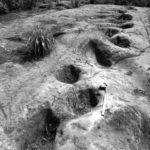By Adrienne Mayor (Regular Contributor) 
In the Jurassic era, massive 70-ton Sauropod dinosaurs tromped around what is now China, leaving deep tracks in mud that became stone. About 150 million years later, a conspicuous Sauropod trackway was discovered by villagers in Tongsi, who believed that the fossil footprints were made by a legendary beast in Chinese folklore.
The striking set of 18 sauropod dinosaur footprints are embedded in rock at Luoguan Mountain (near Zigong City, Fushon County, China). They were “discovered” by Chinese paleontologists in 2009, but it turns out the tracksite had been revered by local people for centuries. Following the ancient trail was thought to bring good fortune.
According to the local oral traditions, the huge oval tracks, about 8 inches across and 12.5 inches long, were made by Divine Lucky Rhinoceros. In the story, the venerable Rhinoceros trudged up Luoguan Mountain to gather Lingzhi — “mushrooms of immortality” — a rare red fungus that grows on very old maple tree stumps. Reishi mushrooms, Ganoderma lingzhi, are still believed to have miraculous medicinal powers. As the great Rhinoceros trekked up the slope seeking mushrooms, he left a trail sunk in stone.
We reported the oral tradition associated with the Sauropod tracks in “The Folklore of Dinosaur Trackways in China: Impact on Paleontology,” by L. Xing, A. Mayor, Y. Chen, J. Harris, and M. Burns, in the journal of trace fossils, Ichnos 18 (2011): 213–20.
What is so interesting about this tale is that there are no wild rhinoceroses in China. In antiquity, however, three different types of Asian rhinoceroses did roam China (along with elephants). Rhinos were depicted realistically in Chinese art as early as 1000 BC. Rhinoceroses were hunted extensively. Killing a rhinoceros was believed to ensure rain. Tough rhino hide was fashioned into armor for warriors. Rhinos were also slaughtered for their horns, prized for medicine and for drinking cups, believed to detect poison. Rhinoceros horn drinking cups were often carved in the distinctive shape of reishi mushrooms, recalling the Lucky Rhino’s search for mushrooms in the Tongsi local tale.
But the unlucky rhinoceros of China was hunted to extinction during the Song Dynasty, in the 13th century. The sad fate of the Chinese rhinoceros gives us an idea of the great antiquity of the local oral tradition about the Divine Lucky Rhinoceros tracks in stone. Venerated yet hunted into extinction, the Chinese rhinoceros only survives today in age-old folk memories of a massive wild beast that disappeared 800 years ago.
Adrienne Mayor, a Research Scholar in Classics and History of Science, Stanford University, is the author of The First Fossil Hunters: Dinosaurs, Mammoths, and Myths in Greek and Roman Times (2011), Fossil Legends of the First Americans (2005), The Poison King: The Life and Legend of Mithradates, nonfiction finalist for the 2009 National Book Award, and The Amazons (2014).
